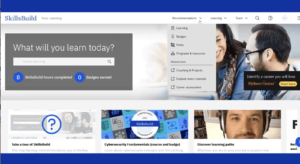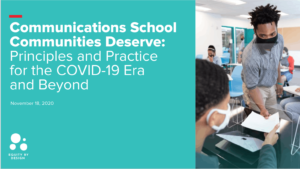Platform Skills Tighten Focus on Effective Communication

In retrospect, I didn’t do a good enough job of preparing my students for their oral presentations when I taught at the project-based learning (PBL) hotspot of New Tech High School in Napa, CA.
I worked with students in groups to jigsaw the oral presentation/communication rubric in an attempt to get them to understand the assessment process. We scheduled practice presentations and used that activity for formative feedback. The students even got to score me on the rubric when I would give an intentionally inert presentation. This became such a popular fad that I once caught a team of seniors scoring the principal on one of his speeches, and it didn’t go well for any of us. Especially me.
But it wasn’t enough. That’s why I’m encouraged to see the new energy around what are now being called “platform skills.” The development of this skill category is mostly occurring in industry but I think it should quickly find its way into the education sector.
According to facilitation expert Guila Muir, platform skills are “presentation behaviors that a trainer uses to transmit content effectively. Not to be confused with skills that guarantee participation (which, in general, only trainers use), both presenters and trainers must demonstrate excellent platform skills to get their messages across.”
According to Muir, there are five key platform skills for trainers. I would argue that these five skills are relevant to classroom teachers and students, not just trainers. Teachers, in particular, focus mostly on the skills needed to engage learners in a replicable activity (training, in business lingo) but neglect the platform skills needed to effectively communicate information required to complete the task.
Skilled facilitators should:
- Clearly communicate session outcomes, topics, goals, and the reason why the session is relevant to the needs of the audience.
- Effectively manage nervousness (yes, even veterans get nervous) so that it doesn’t interfere with the audience’s experience.
- Use a variety of narrative and rhetorical devices (humor, metaphors, analogies, stories) in addition to any technological aids.
- Maintain careful control of body language, including positioning vis a vis the audience.
- End the session with a summary and maintain a high level of energy throughout.
Many of the sites and resources focused on platform skills provide useful tips, which again are just as valuable for teachers and students as they are for professional facilitators. I endorse the guidance provided by Sheri Staak in her piece for Training Magazine. She recommends the following four steps to sharpen platform skills.
- Prepare
- Read your audience
- Rehearse
- Seek feedback
Those of us who work in PBL environments are aware that public displays of knowledge and skills are essential elements of both the High-Quality PBL and Gold Standard PBL frameworks. Anything we can do to better prepare students for success during these presentations is a welcome addition to classroom practice.
Rody Boonchouy, Associate Superintendent of Instructional Services at Davis (CA) Joint Unified School District, is in accord with this thinking: “Schools in our district that explicitly scaffold communication skills and public speaking, or promote presentations of learning, have a distinctly higher degree of student confidence. Though difficult to measure, it’s evident through the quality of student and adult interactions on campus, quality of peer to peer interactions (including conflict resolution, self-advocacy and expression), and satisfaction of parents who tend to know more about their students’ learning due to richer conversations at home or observing the presentations. These skills and the confidence it engenders translates into post-secondary success.”
This skill development will equip them to thrive in college, career and community. Witness the large number of frameworks that list communication (platform) skills as a prerequisite of success: Partnership for 21st Century Learning, OECD, Forbes, and the Association of American Colleges & Universities to name a few.
The Institution of Mechanical Engineers has essentially reverse engineered the discrete elements of effective platform skills and created a nifty PDF that elaborates on key features (Technique, Problem, Strategy, and Benefit). The document, not really a rubric, focuses on platform-skill elements that are familiar to most PBL teachers (pace, body language, eye contact, flow, etc.) and then includes a few that I never even think about (hands, hips, and legs).
This is the type of concrete guidance that was missing from my classroom.
The movement toward reclassifying communication skills into the related but separate channels of training and platform has created a new form of presentation. Appropriately, it is called a “Platform Presentation” and has been adopted by the Stanford School of Medicine. In essence, a platform presentation is a 10-15 minute oral presentation in which a researcher/student shares their original research and then engages the audience and/or expert panel in a Q&A.
That typology solves a labeling problem I and many teachers have struggled with for years. I was never satisfied with using the uber category of “oral presentation” to describe the many different types of stand-and-deliver performances I assessed. Is a debate, panel, or skit the same as, well, a platform presentation? I think not.
As described by Phil Simon in his book The Age of the Platform: How Amazon, Apple, Facebook, and Google Have Redefined Business, we are indeed in the age of the platform. As a corollary, we are in the age of platform skills, and educators would do well to improve their students’ ability to effectively communicate for a purpose and to a target audience.
For more, see:
- The Keys to High-Quality PBL: Public Products and Presentations of Work
- 30 Leaders on the Successes and Challenges of Project-Based Learning
- Introducing a Framework for High-Quality Project Based Learning
Stay in-the-know with innovations in learning by signing up for the weekly Smart Update.







Sanjeeb Sarkar
Very good and useful